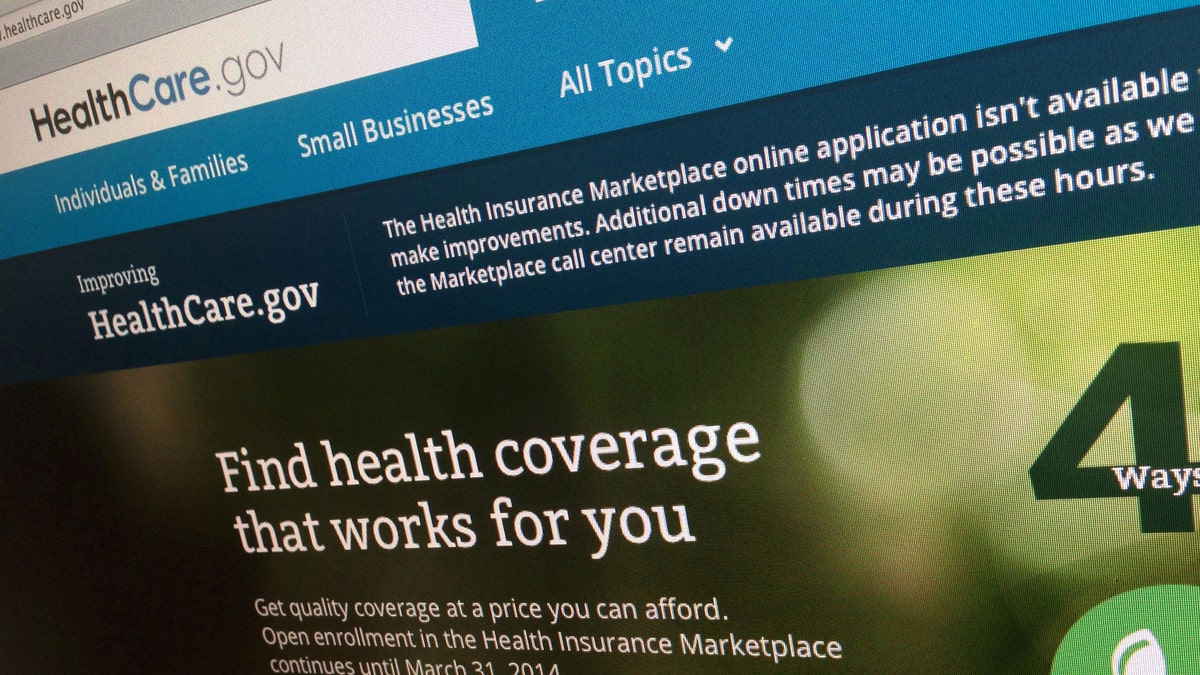
FILE - This Nov. 29, 2013, file photo shows a part of the HealthCare.gov website, photographed in Washington. The administration is warning hundreds of thousands of consumers they risk losing taxpayer-subsidized health insurance unless they act quickly to resolve issues about their citizenship and immigration status. (AP Photo/Jon Elswick, File) (AP)
Remember how President Obama and the Democrats who passed Obamacare were going to “get” the insurance companies? Rhetorically, Obama set out to target big insurance companies—making them the bad guy was central to selling Obamacare as a plan that would help middle and lower class families.
But one of the dirty little secrets of Obamacare is that the biggest insurance companies were willing allies in the fight to pass the law, knowing that they stood to add hundreds of thousands of new members to their networks. And they have. The central part of Obamacare, the individual mandate, may be the most disliked component among the American people, but it is precisely what guarantees insurers new customers.
Today 95 percent of Bayonne [Medical Center's] patients are covered by some type of insurance payment, a very high percentage compared to other urban hospitals.
Of course, these new customers have brought with them profit growth for the insurance industry in leaps and bounds. In 2013, the value of the S&P health insurance index gained 43 percent. Major insurers have seen their revenues rise by billions every year since the passage of Obamacare.
And yet, this comes as middle class and working families continue to be squeezed by rising health care costs. As illustrated last week, “government data show that health care costs are the biggest driver of income inequality in America today.” Pay increases are being eaten up by rising healthcare costs, including higher insurance premiums, and the shrinking American middle class suffers.
Some in the insurance industry appear to not be content with the advantage that they won under Obamacare, which obscures prices for the average consumer/patient even more than before the law was passed. Insurance companies and providers are incentivized to use artificially high price points to start, and end up negotiating a “discounted” middle-ground.
These pricing schemes just add to string of hits on middle and low income families. Providers who dare to look at better ways to implement sound business practices in order to remain operationally viable can find themselves under attack.
For example, one urban hospital in New Jersey, Bayonne Medical Center, has found itself in the crosshairs for seeking to negotiate a more sane pricing structure.
Policy expert Ryan Ellis provides his assessment:
Two recent screaming headlines from the U.K.’s Daily Mail (“That’s painful! New Jersey hospital charges man nearly $9,000 to treat a CUT on his middle finger”) and the New York Times (“New Jersey Hospital Has Highest Billing Rates in the Nation”) were clearly planted as a negotiating leverage tactic by Big Insurance. The hope is to cow providers into charging less in the fake first bill so that the “discount” results in lower payments to providers/bigger profits for insurance companies.
Not long ago, Bayonne Medical Center was on the verge of closing its doors after decades of financial struggle—no surprise when one considers just how much strain medical facilities face in underserved areas. In fact, Hudson County, where Bayonne is located, has the highest rate of uninsured, underinsured, and Medicaid patients in New Jersey.
Bayonne is now on more solid financial footing thanks to new investment, restructuring of management practices, and the negotiation of a more fair reimbursement plan with insurers. Bayonne reached contract agreements with all of the nearly all insurance providers, including the New Jersey’s largest. Today 95 percent of Bayonne's patients are covered by some type of insurance payment, a very high percentage compared to other urban hospitals.
But as Ellis have points out, suddenly there appears to be a coordinated attack designed to pressure Bayonne into giving in to insurance providers with whom they have yet to reach a pricing agreement.
In the current health care environment in which working families are being subjected to strains on their budget and ultimately their well-being, it would seem that health care providers who operate in underserved communities, especially those that are efficient and price effective, could be held up as a model of success. Instead, they face sensationalist headlines designed to create pressure on them to succumb to pricing demands.
All of this just adds to the long list of reasons why the American people need health care reform that puts patients and families in charge of their health care, as opposed to politicians, bureaucrats, and third-party payers. The sooner that real health care reform is passes the better for all of us.
